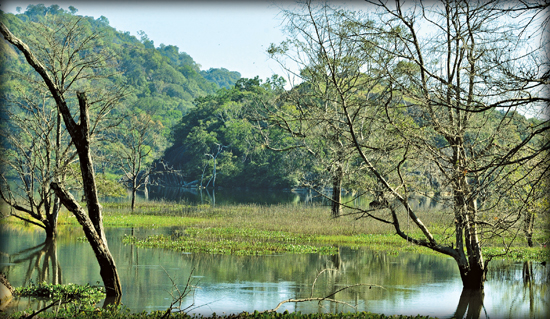|
Buduruwagala:
Devotion inscribed in rock
Story and pictures by Mahil Wijesinghe
|

The central figure on right side of the Buddha is Bodhisatva
Avalokitheswara and to his left is Tara Devi |
With Vesak looming on the horizon, I thought of heading to one of the
better known, but nevertheless less visited sacred sites in the island.
Wellawaya may be a little town in the awe-inspiring mountain ranges of
the Uva province and you may be tempted to pass the area on your way to
more interesting places further afield. But if you take the time, the
area is laden with many awe-inspiring archaeological spots.
The most remarkable sight here is the Buduruwagala rock, a popular
destination for both local and foreign tourists in Sri Lanka. It
literally means the ‘rock that depicts the image of the Buddha’. Located
‘off the beaten track’ in the heart of the jungle off Wellawaya town, it
is possibly one of the most photographed sites in the island. This
unique archaeological site lies in a forest setting six kilometres south
of Wellawaya on the Tissamaharama road.
The rock-cut images of Buduruwagala are believed to be the finest
examples of Mahayana sculpture in Ruhuna Kingdom. There is lush
vegetation all around, complemented by the breathtaking landscape of the
Buduruwagala mountain range.
Canopy
When you enter the forest, the placid tank of Buduruwagala is
dramatically revealed through an opening in the forest canopy. The
skeletons of dead trees and various varieties of birds’ nests on the
trees in the tank instill a sense of serenity to the moment.
 The
water, with its shallow marshy tracts is the perfect feeding and wading
habitat for a wide variety of birds such as cormorants, ebbs and hawk
eagles. When the drought prevails in the area, herds of elephants can be
spotted in the vicinity of the Buduruwagala tank. The
water, with its shallow marshy tracts is the perfect feeding and wading
habitat for a wide variety of birds such as cormorants, ebbs and hawk
eagles. When the drought prevails in the area, herds of elephants can be
spotted in the vicinity of the Buduruwagala tank.
During my stay at the Buduruwagala shrine, I experienced a serene
atmosphere which was truly breathtaking. I saw groups of pilgrims rest
under huge trees for a while, many of them meditating in the stillness
of the jungle under the compassionate eyes of the Buddha.
Here we see a unique assembly of seven figures in high relief,
depicting the highly developed artistic skills of 9th or 10th Century
sculptors of Ruhuna. At 51 feet the central Buddha statue is perhaps the
tallest in Sri Lanka and has been carved out of the living rock. It is
flanked on both sides by two groups of three figures. The eminent
archaeologist, Prof. Senerath Paranavitane believed that this Buddha was
a depiction of the Dipankara Buddha.
Sensuous
To the right of the Buddha statue is a carving of the Bodhisatva
Avalokiteswara draped in a long garb, wearing a turban and a waist band.
To his left, is the beautiful and sensuous Tara Devi, believed to be his
spiritual consort strikingly winsome in the thrice bent posture. Her
body curves towards a very narrow waist and flares out again into
shapely hips with her bosom in bare.
Legend has it, that Tara Devi was born of the tears wept by
Avalokiteswara for the sufferings of the world. On the right of the
Bodhisatva figure is Suddhana Kumara, his constant companion.
|

The placid Buduruwagala tank adds beauty to the site |
To the left of the central Buddha statue are three more figures. At
the centre is believed to be a carving of the future Maitriya Buddha and
on either side of him are Vajirapani and Manjusri. There is a deep dent
in the centre of the rock in the shape of a huge clay lamp and it is
believed that a flame used to be lit here.
An elderly person at the temple, probably a villager told me that
when he was a small boy, he had seen oil leaking from the rock cavity
and that he used to anoint his head with this oil. At present, no oil
leaks from this spot and the only evidence of oil having leaked is a
blackish colouration.
Observing the figures, one can understand that ancient sculptors had
used colour plaster to cover the rock statues to achieve a more refined
and artistic value to the carvings. Even today, looking at the
Bodhisatva statue at the right side of the Buddha statue, one notices a
portion of white plaster in the stone image, as well as another small
piece of plaster on the main Buddha statue. Here on the sheer face of
this rock we see a configuration of carvings related to Mahayana belief.
Seeing the gallery of rock carvings on the isolated rock in a silent
forest, I was impressed not only by the serene beauty of the carvings
but also by the enchanting greenery of the forest, the clear waters and
shadows of dead trees in the Buduruwagala tank. |

